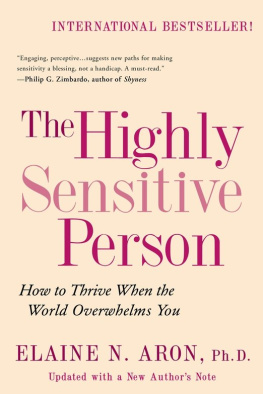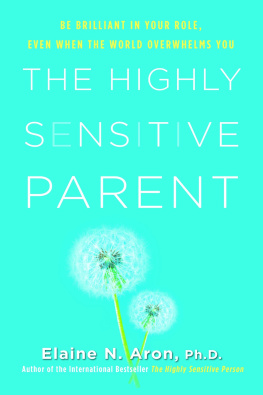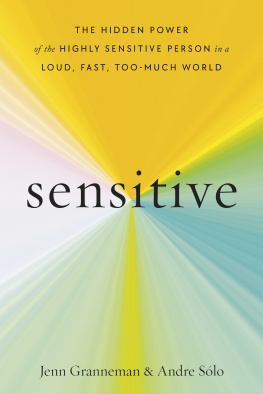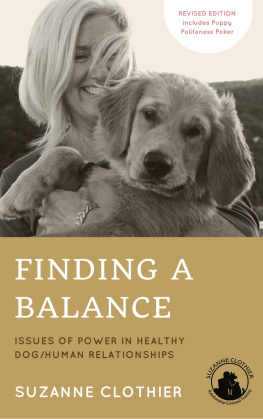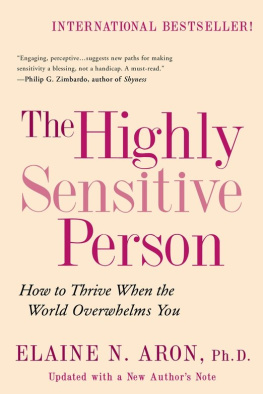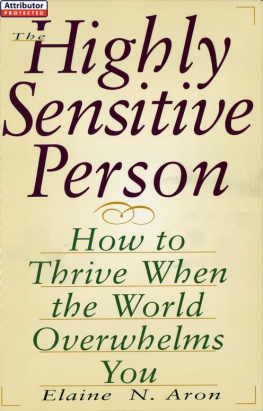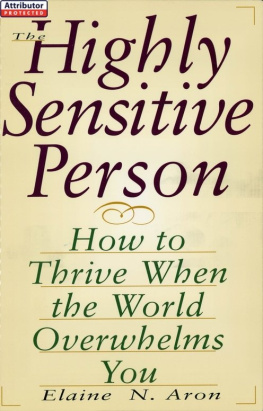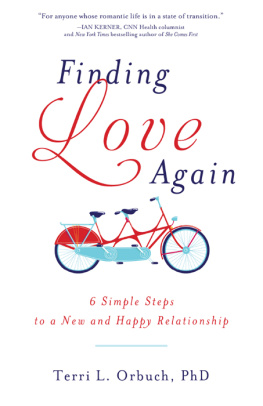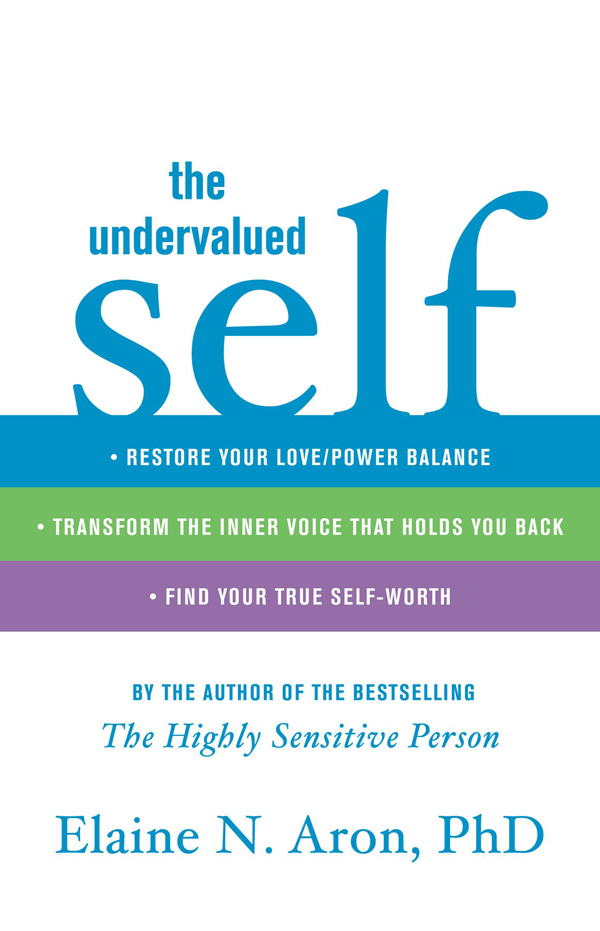Also by Elaine N. Aron, PhD
The Highly Sensitive Person
The Highly Sensitive Person in Love
The Highly Sensitive Child
The Highly Sensitive Persons Workbook
Copyright 2010 by Elaine N. Aron, PhD
All rights reserved. Except as permitted under the U.S. Copyright Act of 1976, no part of this publication may be reproduced, distributed, or transmitted in any form or by any means, or stored in a database or retrieval system, without the prior written permission of the publisher.
Little, Brown and Company
Hachette Book Group
237 Park Avenue
New York, NY 10017
Visit our website at www.HachetteBookGroup.com.
www.twitter.com/littlebrown.
First eBook Edition: April 2010
Little, Brown and Company is a division of Hachette Book Group, Inc. The Little, Brown name and logo are trademarks of Hachette Book Group, Inc.
The persons portrayed in this book are composites of different individuals, with all names and some characteristics changed so that the confidentiality of each is completely protected.
ISBN: 978-0-316-07227-4
To Art
W e all have an undervalued self buried deep inside, a part that can make us feel worthless. It may rise to the surface now and then or, for some of us, it may be a constant companion. It makes us doubt ourselves or feel shy, anxious, or even depressed. It often interferes just when we most need to be accurate in our estimation of our value. It results in low self-esteem, the most common problem addressed by psychotherapists and self-help teachers and the root of most other psychological issues. However, despite all of our work on improving self-esteem in the past decades, the undervalued self is still with us, tagging along and causing trouble. This is largely because, as research has now shown, positive thinking and self-affirmations can make those with low self-esteem feel even worse about themselves.
I never planned to study the undervalued self, but it kept turning up in my patients. In fact, it was what they all had in common. They ranked themselves against others, even if others were not thinking about rank, and they ranked themselves too low.
In addition to being a psychotherapist, I am a social psychologist specializing in the study of love and linking, our natural, innate tendency to like and support one another. I knew that my patients needed and wanted more linking and less ranking. But I also knew that the ranking I was seeing represented another innate behavior, one with the directly opposite effect of linking, namely, a sense of being seen as a competitor and not supported. As a result, I began to think about that problem of low self-esteem in quite a different way.
First I saw that the very phrase low self-esteem implies ranking a judgment that we should climb from low to high. The problem really is inaccurate self-valuing, or undervaluing the self. Second, if low self-esteem is so hard to change, perhaps there are good biological reasons for why we jump so readily to the wrong conclusion about our value compared to that of others. What might those reasons be, and could understanding them help us stop this widespread self-undervaluing?
THE GIANT TASK I UNDERTOOK BY CHANCE
I began to wonder whether seeing ranking as an innate aspect of our behavior could help with the problems created by the undervalued self. Fortunately, I knew from my study of high sensitivity that being aware of what we are born with allows us to adapt better to it. In the case of the undervalued self, it seemed that the problem could be that we need to gain control over built-in reactions associated with ranking conflicts and defeats.
Taking control of innate behaviors is actually something we do all the time, so it is not impossible. For example, some of us have innate fears of heights, blood, snakes, or spiders, fears that evolved because they are valuable for survival, but most of us can control these reactions if we must. We all have strong innate sexual impulses, which are essential for survival to the next generation, but we control these remarkably well. So perhaps we can also learn to control our tendency to undervalue ourselves.
It was a big task, in that in my quest to explain the undervalued self, I had unknowingly embarked on the task of explaining most of our daily behavior the part with love and power at its root and how it can go wrong. Further, I wanted to explain some complicated ideas clearly enough to be useful and to present truly effective ways of dealing with the undervalued self. Knowing that superficial affirmations would not work, I had to help readers recognize and deal with their unconscious, automatic responses.
In some cases simply becoming conscious of what was usually unconscious would be enough, but some readers would have personal histories of defeat and trauma that dramatically reinforced their undervalued selves. Doing something about that would require methods thought to work only in deeper, and therefore lengthy and expensive, psychotherapy. But could a mere book help these readers? I believed it could.
After ten years the giant task is done. I have tried to be as scientific as possible about the innate factors that contribute to the undervalued self without wasting your time with undue explanations. I have outlined how you can explore your personal history so that you can take it into account. And I have provided the kind of deeply layered approach used by the best psychotherapists because I believe you can make use of this even if you are working on your own. Some of you may be in psychotherapy already or may turn to it as a result of reading this book, but I know many of you cannot or will not. I think you can do a great deal of healing on your own under the right conditions, which I have tried to provide.
By the way, I, too, have an undervalued self. Indeed, it has been a hefty, pushy one and has caused me trouble most of my life. I recall giving a lecture early in my career and having some students come up afterward to tell me that although they found the lecture fascinating, my delivery was extremely distracting. They said I spoke as if I thought that I, and what I had to say, was worthless. Eventually I had to do something about my undervalued self. Fortunately, I found excellent help, and what helped me will help you, too.
You will achieve immediate payoffs from simply reading this book. But some of you, like me, will work for years on healing the undervalued self. I am not a wizard, and this book is not an instant solution. If the roots of your problem are many and deep, it will take real effort to bring your undervalued self under control. But this book, with its unique approach and careful guidance, should make your task much, much easier.
HOW TO USE THIS BOOK
This book will be helpful if you simply read it through. But you will gain much more from it if you follow the suggestions in each chapter. Since you will be writing quite a bit at times, buy a journal just for using with this book or start a new folder on your computer.
You will also have to be patient. This book is rich, complex, and deeply layered. Learning from it will be like baking a birthday cake from scratch. Each chapter is an ingredient, but you cannot dump them all into the bowl at once. You have to prepare one set of ingredients and then another, then combine them carefully in stages. Still, it is worth the effort when you are going to celebrate the birth of someone as important as yourself.


